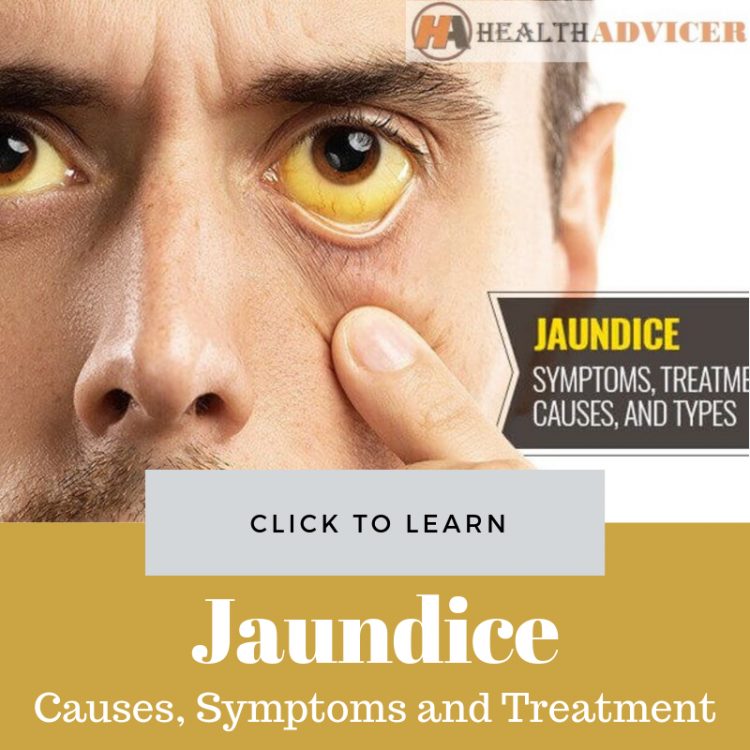Jaundice refers to the yellowish tinge developing on your skin as well as the white areas of your eyes. The condition can result in turning your body fluids yellow. The problem medically known as icterus can result due to the high bilirubin levels in your blood. So, you can see greenish or yellowish pigmentation of the skin. The color appearing on the skin can depend on the bilirubin levels. It can affect both adults and newborns. The causes resulting in the condition in babies and adults vary. The health problem can affect people of all ages. You need to detect the underlying cause to get proper treatment. But, in most of the cases, icterus develops due to problems with the bile duct or liver.
What Is Jaundice?
The condition can develop when bilirubin accumulates in the blood. Bilirubin is the waste material found in your blood. It is produced by the body when the red blood cells breakdown or gets destroyed. Based on the bilirubin levels, your skin can turn from moderate yellow color to brown color. It affects both adults and newborns. When you observe signs of jaundice, then see your doctor immediately. The skin discoloration means you have some underlying problem in blood, liver or gallbladder.
Causes Of Jaundice
Your blood can show the presence of bilirubin, the yellow-orange substance. It develops when the red blood cells die. In normal cases, your liver filters bilirubin from the bloodstream. But, problems with your liver can result in bilirubin buildup. So, it can accumulate in the blood, turning your skin to yellow color. Both adults and newborns can suffer from the problem.
Neonatal Jaundice
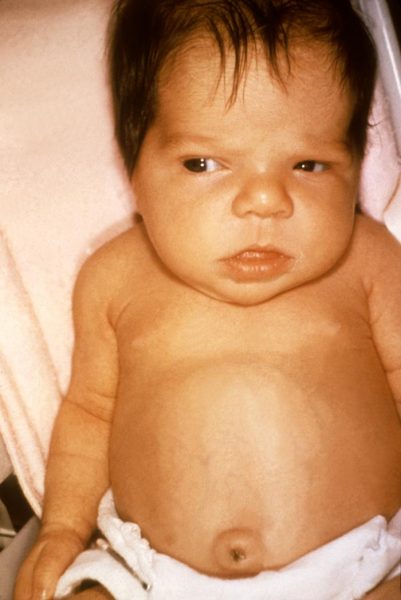
Neonatal jaundice is common in babies around the world. The condition can cause the skin or whites of the eyes to turn yellow. Most babies have high levels of red blood cells. It is due to the liver not developing fully. So, the liver in newborns cannot process bilirubin quickly. So, it can cause your child to develop jaundice a few days after their birth.
Types Of Neonatal Jaundice
In most cases, the yellowing of skin in babies cannot cause any other health problem with proper care. But, ignoring the problem can result in high levels of bilirubin to accumulate in the bloodstream. It can result in the child experiencing brain damage. The condition medically known as kernicterus can result when the bilirubin enters the brain tissue. You can classify the condition in babies into different types.
Physiological Neonatal Jaundice
It is the condition developing in newborns when the liver fails to form completely. The incomplete development of the organ can result in the problem.
Neonatal Jaundice Due To Prematurity
It occurs when a baby is born too early. So, a baby born before 38 weeks of gestation can find it difficult to process bilirubin properly compared to a full-term baby.
Breast Milk Jaundice
It is the type of problem occurring due to breastfeeding problems. Babies with trouble getting enough breast milk can experience dehydration. They can also suffer from low caloric intake. So, it makes them prone to problems like yellowing of the skin.
Incompatible Blood Type
It is the type of icterus developing due to the child and the mother having different blood types. It can result in the mother’s blood to make antibodies. These antibodies can breakdown the red blood cells in the baby. So, it increases the bilirubin levels in the child.
Signs Associated With Neonatal Jaundice
Your doctor can provide immediate medical attention to the child when signs like yellowing of whites of eyes or skin occur. It can also follow other serious signs like:
- Fever
- High-pitched crying for long periods
- Throwing up
- Arching of back and neck
- Have trouble feeding
Diagnosing Neonatal Jaundice
When the babies are born, your doctor can perform several tests to eliminate the high levels of bilirubin in the child’s blood. The tests to determine the problem conclusively are:
- Physical Exam
- Blood tests
- Skin test using transcutaneous bilirubinometer (It measures the reflection when a special light is shone through the skin)
Treatments For Neonatal Jaundice
Based on the underlying cause of the problem, your doctor can suggest the following treatment options for your child.
Light Therapy
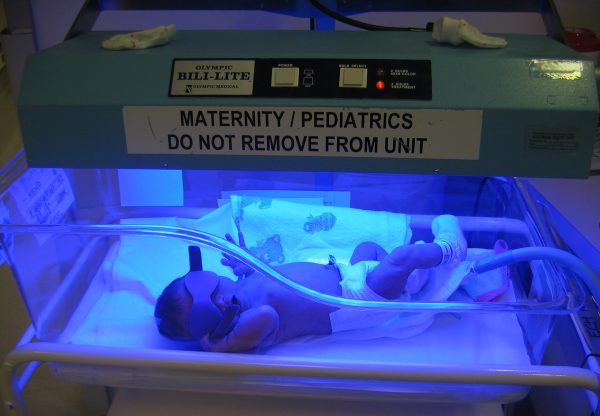
Also known as phototherapy, the light emitted from the special lamp can change the shape and structure of bilirubin molecules. So, your baby’s body can flush out the bilirubin through urine and stool. During the treatment, the baby is placed under the lamp emitting light in the blue-green spectrum only wearing the diaper. The eyepatches protect the baby’s eyes from the light. Your doctor can supplement the therapy by using light-emitting mattress or pad.
Intravenous Immunoglobulin (IVIg)
It is the treatment suggested for jaundice in newborns caused due to different blood types in mother and baby. The immunoglobulin transfusion can reduce the antibodies carried by the baby from their mother. So, the immunoglobulin, a blood protein capable of reducing the antibodies level prevents the rapid breakdown of red blood cells. The treatment option also reduces the need for an exchange transfusion.
Exchange Transfusion
In some rare cases, the different treatments may not show results. In such cases, the baby may need a blood transfusion. The exchange transfusion of blood is performed in the newborn intensive care unit. It involves replacing small amounts of blood with donor blood. So, it dilutes the bilirubin as well as maternal antibodies.
Jaundice In Adults
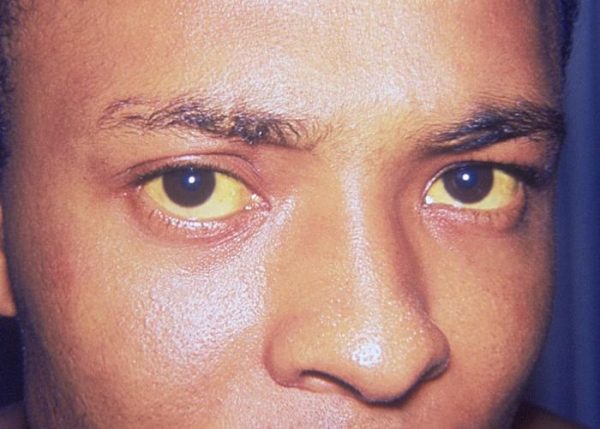
The improper functioning of the liver can result in the condition in adults. The underlying problem can result in liver malfunctioning. So, your liver cannot filter the bilirubin properly. The common causes leading to the condition are:
Hepatitis
It is the condition that develops due to a viral infection. Hepatitis A, B or C virus can damage the liver. So, it causes the liver to malfunction. It makes it impossible to move the bilirubin into the bile ducts. You can suffer from acute hepatitis, which has short duration or chronic hepatitis that lasts for more than six months. In the majority of the cases, acute hepatitis can trigger icterus. In some cases, hepatitis occurs due to the use of certain drugs or autoimmune disorder.
Alcoholic Liver Disease
Consuming a large amount of alcohol for a long period can cause damage to the liver. People drinking alcohol can expect a liver problem. But, the amount of alcohol and time duration for the problem to develop can vary. In most people, liver damage occurs when they drink heavily for more than eight to ten years. In some cases, liver damage can occur due to use of other drugs or herbal products. Exposure to toxins can also lead to liver damage.
Bile Duct Obstruction
The presence of gallstones can cause bile duct obstruction. So, it can cause high levels of bilirubin buildup in your blood. In some cases, pancreatic cancer, rare liver disorders (for example primary sclerosing cholangitis or primary biliary cholangitis) can result in the bile duct obstruction. So, the bile duct obstruction can make your skin appear yellow.
Other Possible Causes
In some rare cases, you can suffer from jaundice due to hereditary disorders. It interferes with the processing of bilirubin in your body. The disorders causing such problems are:
- Gilbert syndrome
- Dubin-Johnson syndrome
- Hemolysis
In such cases, the increase in bilirubin may not trigger visible problems. So, your doctor detects the problem only during routine screening tests.
Types Of Jaundice In Adults
You can classify jaundice into different types based on where they happen within your liver’s process of bilirubin intake and filtering. So, you can classify into four types as:
Pre-Hepatic Jaundice
As the name suggests, the condition occurs when you encounter a problem with the bilirubin before it reaches the liver. Several factors or conditions can elevate your blood’s rate of hemolysis. Hemolysis is the process leading to breaking down of red blood cells in the blood. During the process, it releases hemoglobin and converts into bilirubin. Your liver can process only a specified amount of bilirubin at once. So, the increase in blood’s hemolysis rare can result in bilirubin overflowing into your bodily tissues.
Causes Of Pre-Hepatic Jaundice
Several health conditions can result in elevated rates of hemolysis. The diseases causing the problem are:
- Malaria
It is the infection of the blood caused by a parasite.
- Sickle Cell Anemia
In normal cases, your red blood cells look like a disc. But, the genetic condition can make the red blood cells have a crescent shape.
- Thalassemia
It is a genetic condition that results in the body, making the irregular type of hemoglobin. The abnormal hemoglobin restricts the number of healthy red blood cells in the blood.
Symptoms Of Pre-Hepatic Jaundice
How can you detect the condition? Your body shows certain signs, which indicates the problem. So, monitor your body for the following signs:
- Abdominal pain
- Abnormal weight loss
- Fever
- Cold sweats
- Chills
- Dark urine
- Feeling itchy
- Pale stool
Risk Factors Associated With Pre-Hepatic Jaundice
Some factors increase your odds of developing the problem compared to others. The factors influencing the development of the problem are:
- Drug use
- Family history of blood disorder
- Traveling to malaria-endemic areas around the world
Diagnosing Pre-Hepatic Jaundice
When you experience the signs like yellowing of the skin or whites of eyes, you need to see a doctor. The doctor can suggest the following tests to detect the issue conclusively:
- Urinalysis
- CBC (Complete Blood Count)
- Liver function tests
- Imaging Tests
- HIDA Scan
Diagnosing the problem accurately is important to get proper treatment. The tests help determine if the processing of bilirubin in the liver, biliary ducts or gallbladder encounters no problem.
Treatment For Pre-Hepatic Jaundice
The treatment option for the condition depends on the underlying problem triggering it. So, the options include:
Treatment For Malaria
Medication to destroy the infecting parasite and prevent re-infection
Treatment For Sickle Cell Anemia
- Blood transfusion from a healthy donor
- Medication for infections triggering complications
- Rehydration with IV (intravenous) fluid
Treatment For Spherocytosis
- Blood transfusion to combat anemia
- Folic acid supplements
- Spleen removal (to reduce gallstones and increase red blood cell life)
Treatment For Thalassemia
- Blood transfusions
- Spleen/gallbladder removal surgery
- Bone marrow transplants
Hepatic Jaundice
Hepatic jaundice develops due to problems in the liver. It mainly occurs when you suffer a scar to the liver tissue (cirrhosis). You can even suffer from the problem due to damage or dysfunction to the liver. So, the problem makes the liver ineffective to filter the bilirubin out of the blood. When bilirubin is not filtered to the digestive system for removal, it accumulates and increases the bilirubin levels in the blood.
Causes Of Hepatic Jaundice
Some underlying health conditions can trigger the issue. The most common causes of the condition are:
- Liver Cirrhosis
- Viral Hepatitis
- Primary Biliary Cirrhosis
- Alcoholic Hepatitis
- Leptospirosis
- Liver Cancer
Symptoms Of Hepatic Jaundice
When you suffer from hepatic jaundice, you can experience the following signs:
- Bloody nose
- Loss of appetite
- Weakness
- Skin itching
- Swelling in the legs or abdomen
- Abnormal weight loss
- Pale stool
- Dark urine
- Pain in joints/muscles
- Darkening of skin
- Vomiting
- Fever
- Feeling sick
Risk Factors Of Hepatic Jaundice
The risk factors that increase your chances of getting the problem include:
- Use of recreational drugs
- Consuming a lot of alcohol for a long period
- Use of medications leading to liver damage (for example, certain heart medications or acetaminophen)
- A history of infections affecting the liver
Diagnosing Hepatic Jaundice
Your doctor can perform the following tests to detect the problem affecting the liver conclusively.
- Urinalysis
- CBC (Complete Blood Count)
- Liver function tests
- Antibody tests
- Imaging tests
- Endoscopy
- Biopsy
Based on the results of the diagnostic examination, your doctor develops the ideal treatment plan for managing the problem.
Treatment For Hepatic Jaundice
The treatment options to alleviate hepatic jaundice depends on the health condition triggering it. So, depending on the exact issue, you can get proper treatment.
Treatment For liver Cirrhosis
The accumulation of bilirubin due to excess alcohol consumption needs treatment immediately. So, your doctor suggests the following:
- Quit drinking immediately
- Use beta-blockers
- Reduce inflammation of the liver with antibiotics (through IV)
- Include a low-protein diet
Treatment For Viral Hepatitis
- Take antiviral medications
- Get hepatitis vaccination
- Take plenty of rest
- Drink fluids
Treatment For Primary Biliary Cirrhosis
- Take bile acids to aid with digestion
- Manage itch caused due to the condition with antihistamines
- Take bile-lowering medication
Treatment For Alcoholic Hepatitis
- Quit consuming alcohol
- Take nutrition supplements
- In severe cases, undergo a liver transplant
Treatment For Leptospirosis
- Take antibiotics for an infection
- Use ventilator for breathing trouble
- Undergo dialysis for kidney damage
Treatment For Liver Cancer
- Radiation/chemotherapy to kill cancer cells
- Undergo partial liver resection
- Undergo liver transplant
Post-Hepatic Jaundice
Post-hepatic is also known as obstructive jaundice occurs when your body cannot drain the bilirubin into the digestive tract or bile ducts due to blockage.
Causes Of Post-Hepatic Jaundice
The obstruction can occur due to different reasons. The common causes are:
- Presence of hard calcium deposits (also known as gallstones) causing bile ducts blockage
- The genetic condition leading to missing or narrow bile ducts (biliary atresia)
- Cancer can spread to your bile ducts causing bile duct cancer
- Your pancreas that produces digestive substances can have malignant cells
- When you suffer from inflammation or infection of the pancreas (pancreatitis)
Symptoms Of Post-Hepatic Jaundice
When you suffer from the condition due to obstruction, it can trigger several other symptoms. So, you need to observe your body for signs like:
- Vomiting
- Feeling sick
- Pale stool
- Dark urine
- Diarrhea
- Abdominal pain
- Skin itching
- Abnormal weight loss
- Fever
Risk Factors Associated With Post-Hepatic Jaundice
Some people are more at risk of suffering from the problem compared to others. The factors putting you at risk of the problem are:
- Excess body weight
- Suffer from diabetes
- Eating a low-fiber, high fat diet
- Advanced age
- Having a family history of gallstones
- Female
- Smoking tobacco products
- Consuming alcohol in excess
- Having a previous infection or inflammation of the pancreas
- Constant exposure to industrial chemicals
Diagnosing Post-Hepatic Jaundice
Apart from physical assessment, your doctor can order the following tests to detect the problem conclusively. So, you need to undergo the following tests:
- Urinalysis
- Blood tests (CBC)
- Antibody tests to detect cancer
- Imaging tests to detect obstruction like tumors or gallstones in bile ducts, gallbladder or liver (Ultrasound or MRI)
- Liver tests to rule out hepatic jaundice
- Endoscopy to look at liver, bile ducts, gallbladder to check for obstruction or take a sample to diagnose cancer
Depending on the diagnosis, your doctor can suggest treatment options. Therefore, it is essential to determine the exact cause.
Treatment For Post-Hepatic Jaundice
The treatment for the post-hepatic condition depends entirely on the underlying cause. So, your doctor can suggest treatment to address the cause of the problem. The treatment options available are:
Treatment For Gallstone
Your doctor can suggest the following options to avoid or restrict gallstones production. Therefore, the steps to manage the problem includes:
- Change the diet to prevent gallstones production
- Take medications or undergo treatment to dissolve gallbladder completely
- Remove gallstones or gallbladder entirely
Treatment For Pancreatic Cancer
You need to undergo treatment as early as possible for cancerous presence in the pancreas. You need to undergo one or a combination of the treatment options:
- Chemotherapy
- Radiation therapy
- Surgery to remove cancerous tissue or pancreas completely
Treatment For Bile Duct Cancer
Cancerous cells can develop in the bile ducts. It can cause post-hepatic jaundice. So, the treatment options include:
- Chemotherapy or radiation therapy to destroy cancerous cells
- Surgery to remove cancerous bile ducts or the affected parts of the liver as well as the pancreas
- Liver transplant
Treatment For Pancreatitis
The treatment for infection or inflammation of the pancreas includes the following:
- Getting enough rest
- Injecting pain medication or fluid intravenously (IV)
- Surgery to eliminate the actual cause of inflammation
Treatment For Biliary Atresia
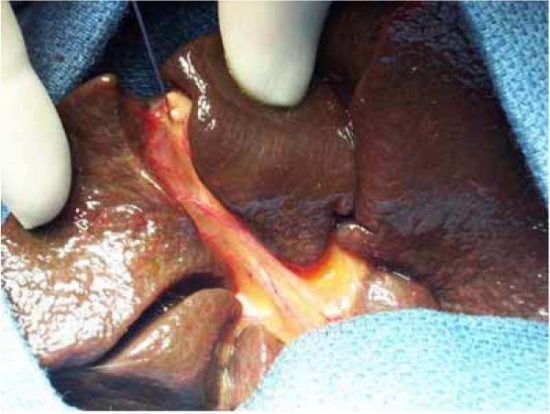
The treatment to manage biliary atresia includes the following:
- Undergo Kasai procedure to replace and remove bile ducts
- Liver transplantation
Preventing Jaundice
Can you prevent yellowing skin in adults? It is possible to prevent the condition by adopting specific measures. The preventive steps can help you avoid the condition.
- Try to avoid hepatitis infection from affecting your body.
- Consume alcohol in moderation. You need to stay within the recommended limits to reduce your risk of the condition.
- Control your weight and maintain it within the acceptable limits. The healthy weight prevents any problems from affecting you.
- High cholesterol levels can result in the excess buildup of bilirubin in your blood. So, maintain healthy cholesterol levels.
Conclusion
Jaundice is the clear indication of high levels of bilirubin in your blood. Though the underlying causes of high bilirubin levels can vary. So, you need to contact your doctor to determine the exact health problem triggering excess bilirubin accumulation in the blood. Make an appointment when you see changes in your skin color or whites of the eyes. You can manage certain conditions with lifestyle and diet changes. In some severe cases, you need long-term or invasive treatment to manage the problem. With proper care and attention, it is possible to deal with the problem and avoid further complications.
View Article Sources
